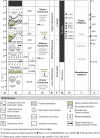Pampean megamammals in Europe: the fossil collections from Santiago Roth
- PMID: 37790996
- PMCID: PMC10542304
- DOI: 10.1186/s13358-023-00283-5
Pampean megamammals in Europe: the fossil collections from Santiago Roth
Abstract
Santiago Roth was a Swiss fossil finder, naturalist, and paleontologist that emigrated to Argentina in 1866. His work largely influenced the discipline in the country at the end of the twentieth century, particularly the stratigraphy of the Pampean region. Some of his collections of Pampean fossils were sold to museums and private collectors in Europe and were accompanied by elaborated catalogues. Fossils in the Roth's catalogues N° 2 and 3 are housed today in the Natural History Museum of Denmark, fossils from catalogues N° 4 to 6, were sold to Swiss museums, with Catalogue N° 5 currently housed at the Department of Paleontology, Universität Zürich. Here, we provide a general framework on the stratigraphy from the Roth's Pampean fossil sites, summarize the history of the Pampean fossils in Europe originally collected by Roth, and provide historical and curatorial details of the Roth's collection at the Department of Paleontology, Universität Zürich.
Supplementary information: The online version contains supplementary material available at 10.1186/s13358-023-00283-5.
Santiago Roth fue un buscador de fósiles, naturalista y paleontólogo suizo que emigró a la Argentina en 1866. Su obra influyó en gran medida en la disciplina del país a fines del siglo XX, con algunos aportes que son pilares, en particular aquellos para la comprensión de la estratigrafía de la Región Pampeana. Algunas de sus colecciones de fósiles pampeanos fueron vendidas a museos y coleccionistas privados en Europa y estaban acompañadas de catálogos elaborados. Los fósiles de los catálogos N° 2 y 3 de Roth se encuentran hoy en el Museo de Historia Natural de Dinamarca, los fósiles de los catálogos N° 4 a 6 fueron vendidos a museos suizos, mientras que el Catálogo N° 5 en particular está alojado actualmente en el Departamento de Paleontología, Universidad de Zurich. Aquí proporcionamos un marco general sobre la estratigrafía de los sitios de los fósiles pampeanos de Roth, resumimos la historia de los fósiles pampeanos en Europa colectados originalmente por Roth y brindamos detalles históricos y curatoriales de la colección de Roth del Departamento de Paleontología, Universidad de Zurich.
Keywords: Argentina; Europe; Fossils; Nineteenth century explorations; Quaternary; South America.
© Akademie der Naturwissenschaften Schweiz (SCNAT) 2023.
Conflict of interest statement
Competing interestsThe authors declare that they have no competing interests.
Figures











References
-
- Ameghino F. La antigüedad del hombre en el Plata. Tomo segundo. G. Masson y Igon; 1881.
-
- Ameghino, F. (1889). Contribución al conocimiento de los mamíferos fósiles de la República argentina. Actas de la Academia Nacional de Ciencias en Córdoba, 6, 1–1027 and Atlas, 98 pls.
-
- Ameghino F. Las formaciones sedimentarias de la región litoral de Mar del Plata y Chapalmalán. Anales Del Museo Nacional De Buenos Aires. 1908;3(10):343–428.
-
- Beaubien HF. Field conservation of skeletal remains: Stabilization treatment techniques and implications for future analysis. Advances in Archaeological Practice. 2019;7(1):23–29. doi: 10.1017/aap.2018.36. - DOI
-
- Bond M. Santiago Roth. Revista Museo, Fundación Museo De La Plata. 1999;2(13):33–37.
LinkOut - more resources
Full Text Sources
